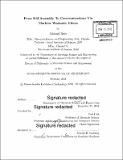| dc.contributor.advisor | Yoel Fink. | en_US |
| dc.contributor.author | Rein, Michael, Ph. D. Massachusetts Institute of Technology | en_US |
| dc.contributor.other | Massachusetts Institute of Technology. Department of Materials Science and Engineering. | en_US |
| dc.date.accessioned | 2018-05-23T16:31:36Z | |
| dc.date.available | 2018-05-23T16:31:36Z | |
| dc.date.copyright | 2018 | en_US |
| dc.date.issued | 2018 | en_US |
| dc.identifier.uri | http://hdl.handle.net/1721.1/115716 | |
| dc.description | Thesis: Ph. D., Massachusetts Institute of Technology, Department of Materials Science and Engineering, 2018. | en_US |
| dc.description | Cataloged from PDF version of thesis. | en_US |
| dc.description | Includes bibliographical references (pages 121-128). | en_US |
| dc.description.abstract | Fibers and fabrics are among the earliest forms of human expression, and yet they have not progressed much from a functional standpoint over the course of history. Recently, a new family of fibers composed of conductors, semiconductors and insulators has emerged. These fibers can achieve device attributes, yet are fabricated using scalable preform-based fiber-processing methods, yielding kilometers of functional fiber devices. Co-draw of different materials is possible for numerous material combinations and sizes, where one of the limiting factors to a continuous feature size in fibers is the Rayleigh-Plateau capillary instability. In my thesis I have shown that it is possible to utilize this adverse fluid instability phenomenon to fabricate uniformly sized and uniformly structured spherical particles internal to the fibers. Judicial choice of the materials and control over the kinetics of this process allowed to integrate the spherical particles into an active fiber device. We have introduced additional ability to control the structure of the fiber by making this process selective, forming high density array of self-assembled spherical photodetectors, connected to continuous electrodes. This fiber structure shows enhanced photoconductivity and sensitivity to wavelength variation, due to spherical geometry of the photoresistive domains. Additionally, an alternative strategy for integrating active devices into fibers was demonstrated. Rather than addressing all the challenges of thermal drawing, we have developed a method to directly integrate commercial functional devices (light emitting diodes, photodetectors etc.) into fibers through thermal drawing. We package these devices internal to the fibers in high density and integrate them with conductive buses, during the thermal draw. This approach enables to combine the benefits of several technologies - high-efficiency devices integrated into kilometer long fibers, which could be weaved into highly functional fabrics. Endowing fibers with active devices will potentially establish a new generation of multifunctional fibers, with highly desired electronic properties. For example, flexible and resilient light emitting fibers could be integrated into textiles to enable covert, optical signal transmission from the soldier uniform to the external world, or high bandwidth photodetectors could be embedded into garments to allow high volume information reception via LiFi (WiFi through light). | en_US |
| dc.description.statementofresponsibility | by Michael Rein. | en_US |
| dc.format.extent | 128 pages | en_US |
| dc.language.iso | eng | en_US |
| dc.publisher | Massachusetts Institute of Technology | en_US |
| dc.rights | MIT theses are protected by copyright. They may be viewed, downloaded, or printed from this source but further reproduction or distribution in any format is prohibited without written permission. | en_US |
| dc.rights.uri | http://dspace.mit.edu/handle/1721.1/7582 | en_US |
| dc.subject | Materials Science and Engineering. | en_US |
| dc.title | From self-assembly to communications via machine washable fibers | en_US |
| dc.type | Thesis | en_US |
| dc.description.degree | Ph. D. | en_US |
| dc.contributor.department | Massachusetts Institute of Technology. Department of Materials Science and Engineering | |
| dc.identifier.oclc | 1036986467 | en_US |
